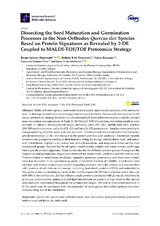Mostrar el registro sencillo del ítem
Dissecting the Seed Maturation and Germination Processes in the Non-Orthodox Quercus ilex Species Based on Protein Signatures as Revealed by 2-DE Coupled to MALDI-TOF/TOF Proteomics Strategy
| dc.contributor.author | Sghaier-Hammami, Besma | |
| dc.contributor.author | Hammami, Sofiene B.M. | |
| dc.contributor.author | Baazaoui, Narjes | |
| dc.contributor.author | Gómez Díaz, Consuelo | |
| dc.contributor.author | Jorrín-Novo, Jesús V. | |
| dc.date.accessioned | 2020-07-10T10:25:14Z | |
| dc.date.available | 2020-07-10T10:25:14Z | |
| dc.date.issued | 2020 | |
| dc.identifier.uri | http://hdl.handle.net/10396/20303 | |
| dc.description.abstract | Unlike orthodox species, seed recalcitrance is poorly understood, especially at the molecular level. In this regard, seed maturation and germination were studied in the non-orthodox Quercus ilex by using a proteomics strategy based on two-dimensional gel electrophoresis coupled to matrix-assisted laser desorption ionization/time of flight (2-DE-MALDI-TOF).Cotyledons and embryo/radicle were sampled at different developmental stages, including early (M1–M3), middle (M4–M7), and late (M8–M9) seed maturation, and early (G1–G3) and late (G4–G5) germination. Samples corresponding to non-germinating, inviable, seeds were also included. Protein extracts were subjected to 2-dimensional gel electrophoresis (2-DE) and changes in the protein profiles were analyzed. Identified variable proteins were grouped according to their function, being the energy, carbohydrate, lipid, and amino acid metabolisms, together with protein fate, redox homeostasis, and response to stress are the most represented groups. Beyond the visual aspect, morphometry, weight, and water content, each stage had a specific protein signature. Clear tendencies for the different protein groups throughout the maturation and germination stages were observed for, respectively, cotyledon and the embryo axis. Proteins related to metabolism, translation, legumins, proteases, proteasome, and those stress related were less abundant in non-germinating seeds, it related to the loss of viability. Cotyledons were enriched with reserve proteins and protein-degrading enzymes, while the embryo axis was enriched with proteins of cell defense and rescue, including heat-shock proteins (HSPs) and antioxidants. The peaks of enzyme proteins occurred at the middle stages (M6–M7) in cotyledons and at late ones (M8–M9) in the embryo axis. Unlike orthodox seeds, proteins associated with glycolysis, tricarboxylic acid cycle, carbohydrate, amino acid and lipid metabolism are present at high levels in the mature seed and were maintained throughout the germination stages. The lack of desiccation tolerance in Q. ilex seeds may be associated with the repression of some genes, late embryogenesis abundant proteins being one of the candidates. | es_ES |
| dc.format.mimetype | application/pdf | es_ES |
| dc.language.iso | eng | es_ES |
| dc.publisher | MDPI | es_ES |
| dc.rights | https://creativecommons.org/licenses/by/4.0/ | es_ES |
| dc.source | International Journal of Molecular Sciences 21(14), 4870 (2020) | es_ES |
| dc.subject | Quercus ilex | es_ES |
| dc.subject | Acorns | es_ES |
| dc.subject | Non-orthodox seeds | es_ES |
| dc.subject | Seed maturation | es_ES |
| dc.subject | Seed germination | es_ES |
| dc.subject | Proteomics | es_ES |
| dc.subject | Embryo axis | es_ES |
| dc.subject | Cotyledon | es_ES |
| dc.subject | Inviable seeds | es_ES |
| dc.title | Dissecting the Seed Maturation and Germination Processes in the Non-Orthodox Quercus ilex Species Based on Protein Signatures as Revealed by 2-DE Coupled to MALDI-TOF/TOF Proteomics Strategy | es_ES |
| dc.type | info:eu-repo/semantics/article | es_ES |
| dc.relation.publisherversion | http://dx.doi.org/10.3390/ijms21144870 | es_ES |
| dc.rights.accessRights | info:eu-repo/semantics/openAccess | es_ES |

